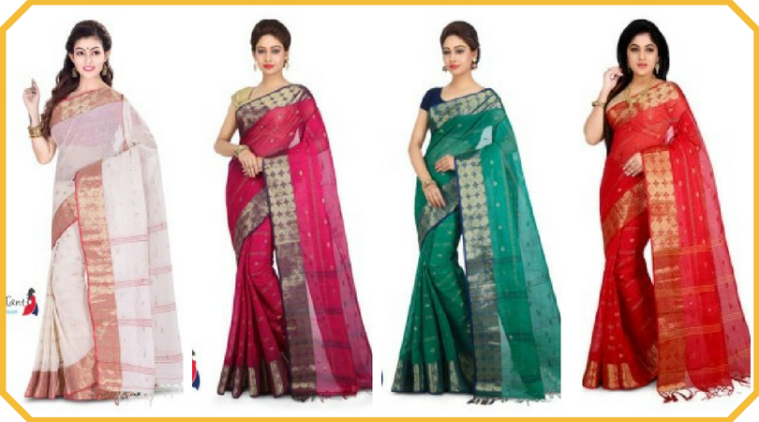There is probably no other piece of clothing more identifiable with any region of the world than sarees are with Bengali women. For centuries sarees have adorned Bengali women, and continue to do so on both sides of the border in West Bengal and Bangladesh. When it comes to the sarees that women from Bengal especially prefer, two names, Tant and Baluchari come to mind. While Baluchari sarees are usually put aside for special occasions, tant sarees are ideal for everyday use. There are certain aspects of tant sarees that can be called rather interesting, and they have been discussed as follows.

Noteworthy Facts about Tant Sarees
- Origin
Tant flourished during the Mughal period. This was a time when Bengali weavers were encouraged by the Empire to carry on their craft under royal patronage. During the British rule, the Englishmen tried their best to destroy the tant industry in order to safeguard their textile industry at Manchester. They were largely unsuccessful in this endeavour as the tant sarees continued to make impressive inroads into every Bengali house.
- Affordability
Due to the fact that tant sarees are essentially produced keeping in mind everyday use, they are available at reasonably inexpensive prices. This encourages more people to buy Bengali tant saree in India and wear it every day, as in the back of everyone’s mind they know that if one gets spoiled, purchasing a replacement will not be too big an issue.
- Comfort–factor
Because tant sarees are made from cotton, they are one of the most comfortable to wear. Regardless of the weather, tant provides excellent ventilation. So, whether it is the punishing Indian summer season or the winter, tant sarees will ensure that the woman wearing it is at her comfortable best. One of the most impressive qualities of tant sarees is its ability to thermo-regulate.
- Production Centres Today
With the departure of the British and partition of Bengal, the skilled weavers settled in and around Hoogly, Burdwan, and Nadia. With the support of the government, they excelled in their craftsmanship. Bengali tant sarees are presently produced on both sides of the border. In West Bengal, the major tant producing places are Fulia, Shantipur, Dhaniakhali, Kalna, Begampur and Atpur. In Bangladesh, the expert tant weaving centres can be found in Dhaka and Tangail. Every place incorporates their own theme or motif into the sarees they make, giving the cloth a unique identification mark that expert eyes can pick up.
- Motifs and Themes
As discussed, there are various themes and motifs that can be found on a traditional Bengali tant saree. Some of the most common are the elephant, bumblebee, royal palace, half-moon, star, flower, and spiral.
As you can see, there are more to tant sarees than meet the eye on the first look. The industry has been in constant business for centuries, and even with the infusion of western culture into Indian society, the want for classical Bengali sarees don’t seem to be diminishing anytime soon.